1. Flamingo

Flamingos aren’t born pink, they earn it. These tall, wading birds start life as dull, grayish-white, a far cry from their famous bubblegum glow. The transformation comes from their food: tiny algae and shrimp packed with carotenoids, the same pigments that make carrots orange and salmon pink. As flamingos digest these pigments, their livers break them down and deposit the resulting color into their skin and feathers. The more they eat, the pinker they become. In fact, flamingos in the wild often show off deeper hues than their zoo counterparts because their diets are richer in the right carotenoids. Without it, their feathers fade to beige. You could call them living mood rings for nutrition.
They’re found in warm, watery regions around the globe, including Africa, South America, and the Caribbean. Flamingos prefer extreme environments like soda lakes or brackish lagoons where few predators dare to follow. They feed with their heads upside down, using their oddly bent beaks like built-in sieves to strain food from the muck. Social to the extreme, flamingos gather in colonies that can number in the thousands. Their synchronized group behaviors, such as feeding, nesting, and even marching, are part dance, part survival strategy. Mating displays include elaborate head-flagging and wing salutes that make a peacock look low-key. While their color grabs attention, it’s really their teamwork and adaptability that enables them to thrive. The pink isn’t just an expression for them. It’s a full-time job.
2. Amazon River Dolphin
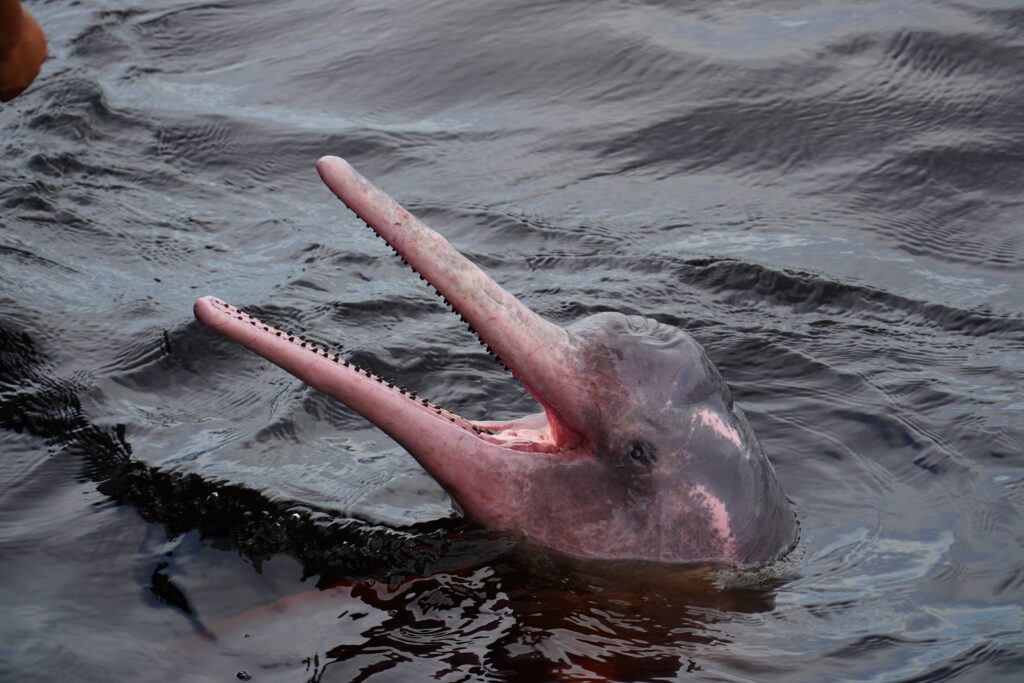
Also known as the boto, the Amazon River dolphin is one of the few freshwater dolphins in the world and arguably the most eye-catching. Males, in particular, can appear a brilliant pink, a color that intensifies with age and activity. Scientists believe this coloration may serve as a signal of dominance or health, much like the brighter feathers that indicate fitness in birds. The pink isn’t just for show; it’s influenced by both capillary visibility through their thin skin and repeated scarring from fights over mates. These dolphins bruise easily, and their skin often flushes more vividly after roughhousing or excitement, kind of like a full-body blush. Found throughout the Amazon and Orinoco river basins, they swim through flooded forests during rainy seasons, navigating tight spaces with sonar so refined it can detect a fish hidden under a riverbed leaf.
Despite their playful reputation, botos are incredibly intelligent and have complex social structures. They’ve even been observed using tools, such as carrying branches or clumps of grass, which researchers believe may be part of mating displays. Local folklore paints them as shapeshifters who turn into handsome men at night, a myth that persists in parts of Brazil and Peru. Sadly, their populations are declining due to habitat destruction, mercury pollution from mining, and accidental entanglement in fishing gear. The International Union for Conservation of Nature lists them as endangered. Yet even with conservation challenges, these “pink ghosts of the river” remain one of nature’s most fascinating enigmas: part mammal, part myth, and entirely unique.
3. Axolotl
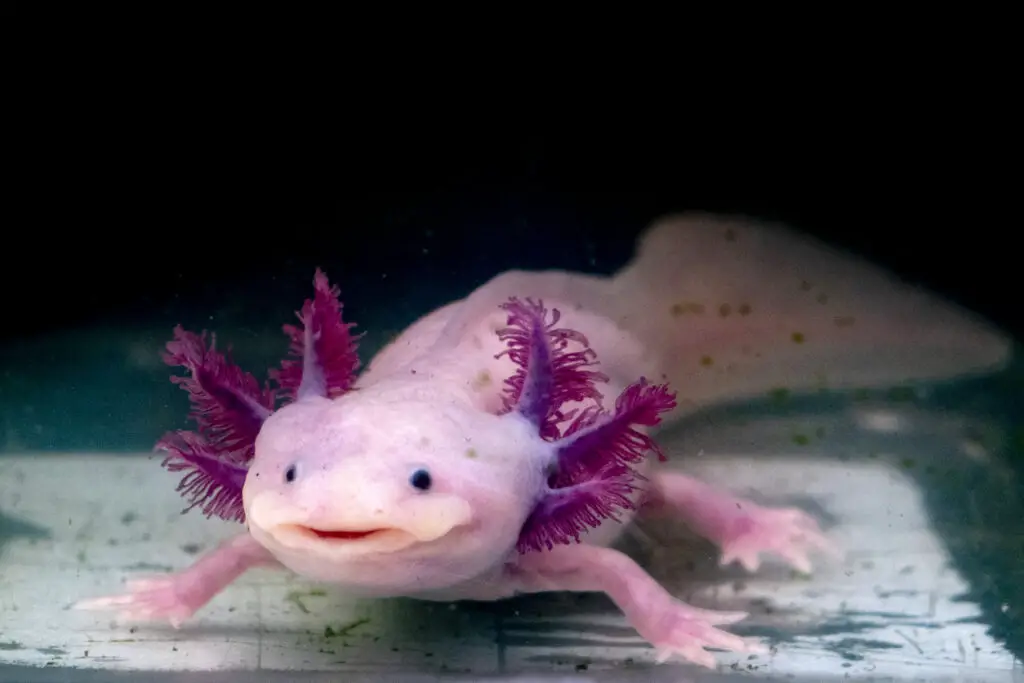
The axolotl might look like a fantasy creature, but it’s 100 percent real and critically endangered. Native to a network of lakes and canals around Mexico City, this amphibian is best known for something scientists call neoteny. That means it never truly matures. Instead of undergoing the typical metamorphosis from aquatic larva to land-dwelling adult, the axolotl stays in its youthful, water-bound form for life. Many appear pale pink, especially the leucistic variety, which lacks most pigment except for black eyes. Their feathery, external gills fan out like soft coral, giving them a surreal, alien beauty. These pink varieties are common in captivity, but wild axolotls tend to be darker in color to better blend with their natural environment. Their ability to regenerate limbs, spinal cords, and even parts of the brain has made them a hot subject in regenerative medicine research.
In the wild, axolotls are nearly extinct due to habitat loss, pollution, and the introduction of invasive species in their native waters. Conservation efforts include breeding programs and the creation of “sheltered canals” that mimic their natural habitat, protecting them from predators such as non-native tilapia. Unlike many amphibians, axolotls don’t require land to survive, making them ideal for lab studies and home aquariums. Their genome is ten times larger than that of humans, a fact that baffles and intrigues geneticists. Yet despite all this scientific importance, their survival remains uncertain. You could say they’re stuck in perpetual youth, but in terms of conservation, time may be running out. They’re the Peter Pans of the animal kingdom, and they’re counting on us not to grow indifferent.
4. Roseate Spoonbill
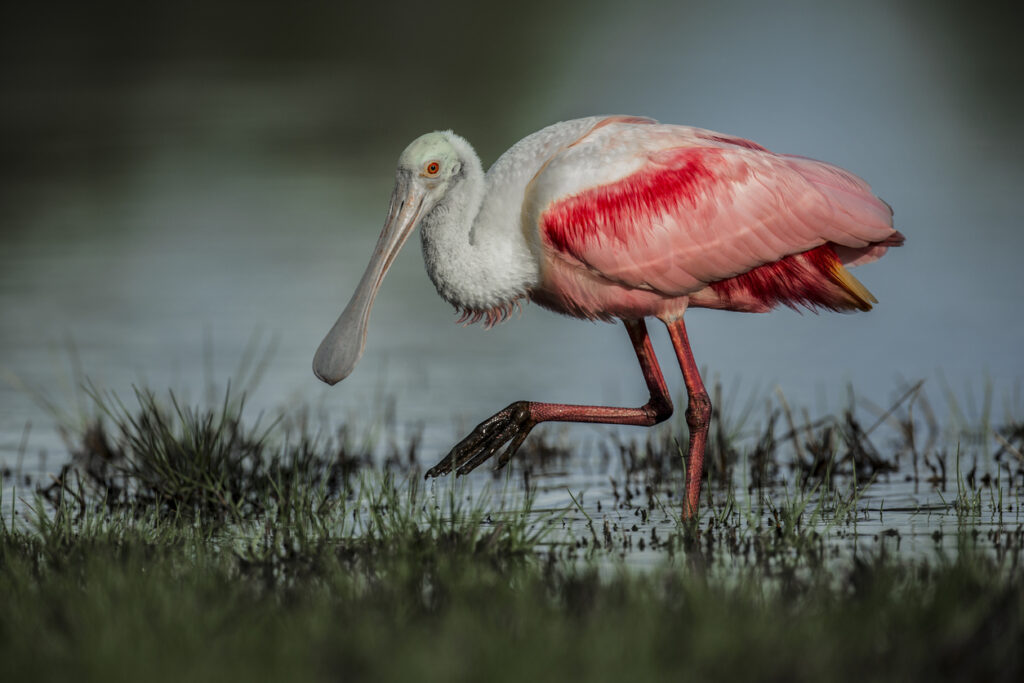
The roseate spoonbill looks like a flamingo crossed with a kitchen utensil and somehow pulls it off. Native to the southeastern United States, Central America, and coastal regions of South America, this wading bird stands out thanks to its soft-to-vibrant pink feathers and its unmistakable spoon-shaped bill. Unlike flamingos, spoonbills don’t get their color from shrimp but from carotenoid pigments in the crustaceans and aquatic invertebrates they eat. Their feathers range in tone depending on age, sex, and diet, from pale rose to highlighter magenta. Juveniles start off whitish and gradually pinken with age, much like flamingos but with a little less fanfare. That wide, flat bill isn’t just a fashion statement; it’s used like a pair of tongs to sift through mud and shallow water for prey. Watching them feed is oddly mesmerizing, like a bird performing a windshield-wiper ballet.
These birds nest in colonies, often with herons and ibises, and prefer isolated mangrove islands or marshes for safety. While once hunted for their striking feathers during the plume trade of the 1800s, roseate spoonbills have made a modest comeback thanks to conservation protections. According to Audubon data, their numbers are now relatively stable, but sea level rise and wetland destruction still threaten their breeding grounds. Despite being related to the stork, the spoonbill feels more like a flamboyant cousin of the flamingo who got tired of the spotlight and chose swamp life instead. They’re flashy, efficient, and somehow both graceful and awkward all at once. In the world of pink birds, the spoonbill is the art-school rebel, just as elegant but with a little more edge.
5. Pink Katydid

The pink katydid is what happens when nature hits “randomize” and accidentally creates a living Valentine. These bubblegum-colored insects are an extremely rare morph of the typically green katydid, caused by a genetic condition called erythrism. Similar to albinism, erythrism affects pigmentation, resulting in pink or reddish tones. It’s estimated that only about 1 in 500 katydids show this coloration, making sightings incredibly rare in the wild. Unlike their green relatives, which blend into leaves effortlessly, pink katydids stand out like candy in a salad, making them great for photos but not so great for survival. Most are found in eastern North America, especially during late summer when katydids are fully grown and active. Their bodies resemble leaves, with textured wings and long antennae, making the color clash all the more surreal.
The pink hue doesn’t serve any evolutionary advantage. In fact, it’s likely a liability since the bright color increases visibility to predators like birds and frogs. Still, when raised in captivity, where camouflage isn’t a matter of life or death, these pink anomalies thrive just like their green counterparts. Some insect enthusiasts even breed them selectively for the color, though it’s challenging to maintain due to the recessive genetics involved. Their chirping, created by rubbing their wings together, sounds just like that of regular katydids and adds to late summer’s ambient noise. Despite their Barbie-pink appearance, they’re not cuddly or sweet; they’re still sharp, jawed herbivores that feed on leaves, flowers, and stems. Think of them as nature’s version of limited edition: rare, visually striking, and genetically unpredictable.
6. Orchid Mantis
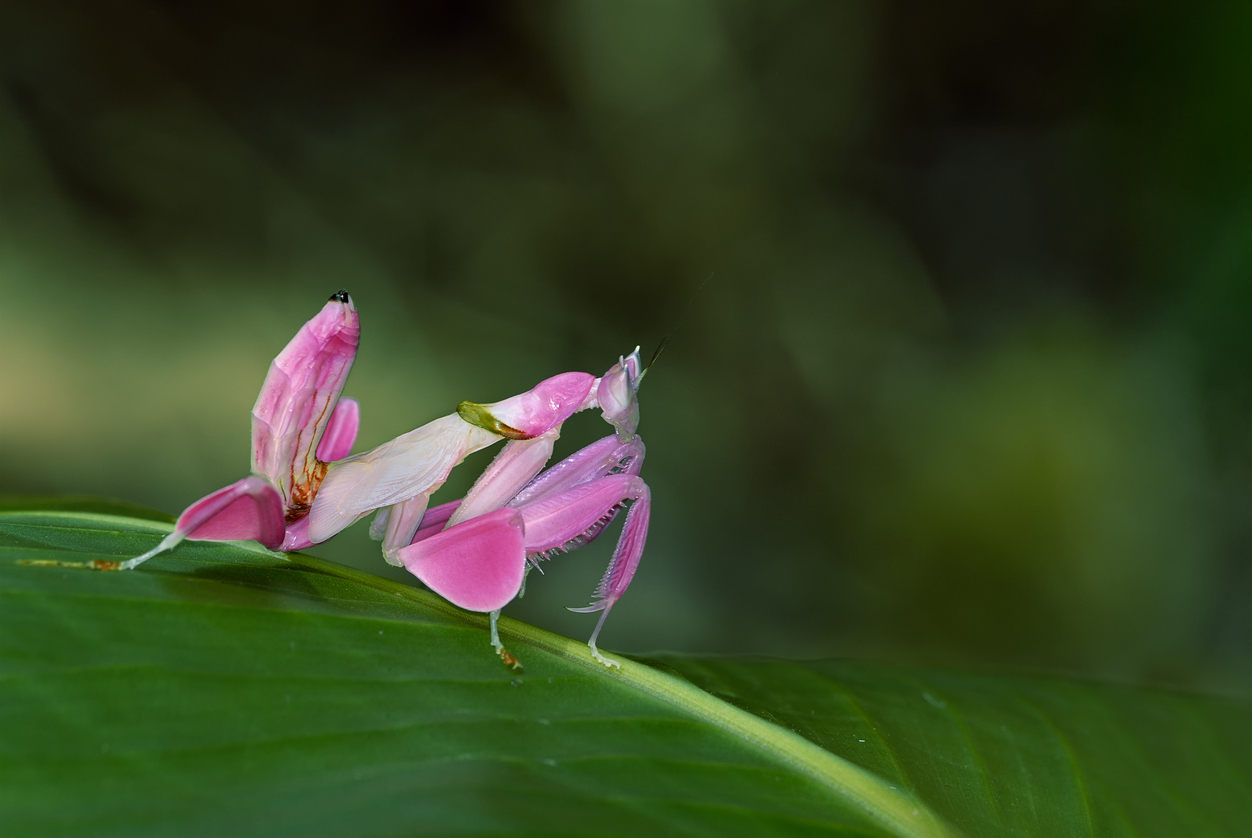
The orchid mantis isn’t just pink. It’s haute couture with a hunger for blood. Native to the tropical forests of Southeast Asia, particularly Malaysia and Indonesia, this mantis has evolved to resemble a flower petal nearly perfectly. Its soft pink, white, and lavender tones, combined with petal-shaped legs and a slow, swaying motion, let it blend perfectly into real blossoms. Unlike simple camouflage, this mimicry is aggressive in nature. The orchid mantis doesn’t just hide from predators; it lures in pollinators like bees and butterflies, which think it’s part of the flower. When the unsuspecting prey gets close enough, it strikes with lightning-fast reflexes. Studies have shown that orchid mantises can attract more insects than the actual flowers they mimic, making them one of nature’s most convincing impostors.
Females are significantly larger than males, reaching up to two and a half inches long, and are the deadlier of the sexes. They can even prey on small lizards or frogs when the opportunity arises. In captivity, their coloration can shift depending on humidity, temperature, and background, but wild ones tend to lean pinker, especially when perched among orchids or bougainvillea. While they look delicate, orchid mantises are formidable predators with an appetite to match their beauty. Their color doesn’t just dazzle, it kills. And yet, their elegance continues to fascinate entomologists, photographers, and exotic pet collectors alike. If a Victoria’s Secret model and a ninja assassin had a baby insect, this would be it.
7. Pygmy Seahorse
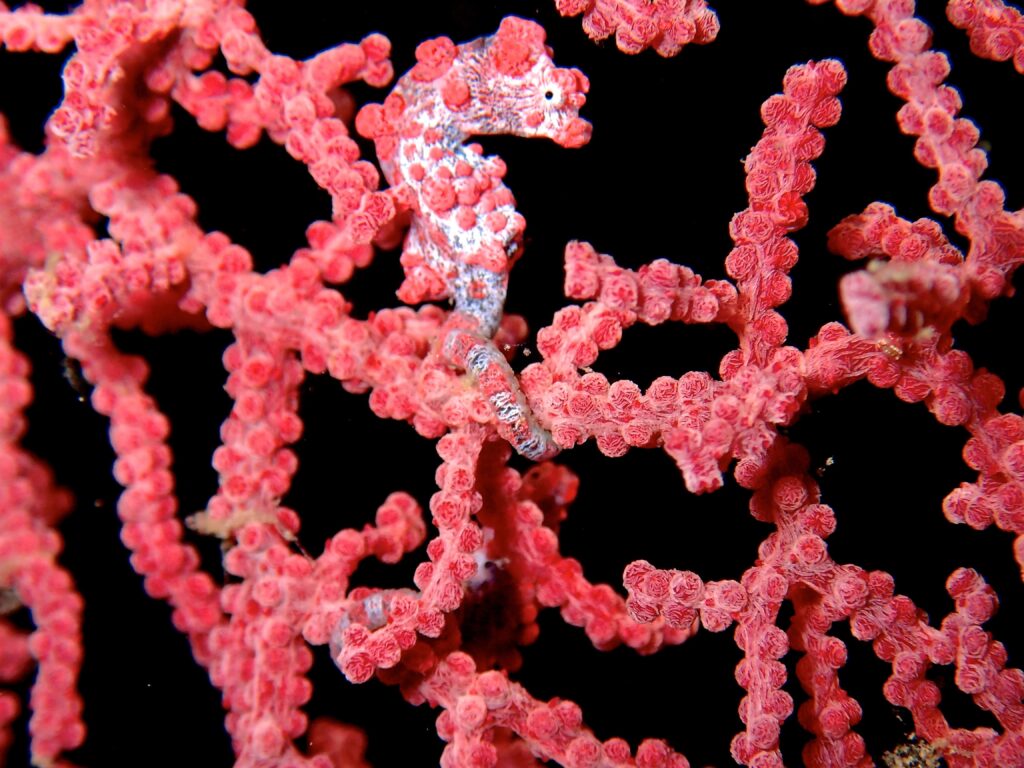
Pygmy seahorses are more miniature than a paperclip and nearly impossible to find unless you know exactly where to look. Most famously, Hippocampus bargibanti, one of several pygmy seahorse species, matches the exact color and texture of the pink gorgonian coral it clings to. These tiny fish, typically less than one inch long, weren’t even discovered until a scuba diver accidentally collected a coral sample in 1969 and noticed the “bumps” were alive. Their camouflage is so perfect that even experienced marine biologists can overlook them entirely. The pink color isn’t universal; it’s context-dependent. If a pygmy seahorse lives on yellow coral, it turns yellow. If the coral is pink, so is the seahorse down to the bumpy tubercles that mimic the coral’s polyps.
They’re found in the coral reefs of the Indo-Pacific, especially around Indonesia, Papua New Guinea, and the Philippines. Unlike larger seahorses, pygmy species are timid and sedentary, spending most of their lives anchored to a single coral fan. Their tails curl tightly around branches, and they feed on tiny plankton that drift past in the current. Reproduction flips the script just like their larger cousins; it’s the males who get pregnant, brooding the fertilized eggs in a pouch until birth. Because they’re so small and fragile, pygmy seahorses are vulnerable to reef damage and climate change. They don’t adapt well to aquariums and remain one of the ocean’s most elusive pink gems. Think of them as the fairy dust of the reef world, fleeting, fragile, and almost too perfect to be real.
8. Hairy Squat Lobster
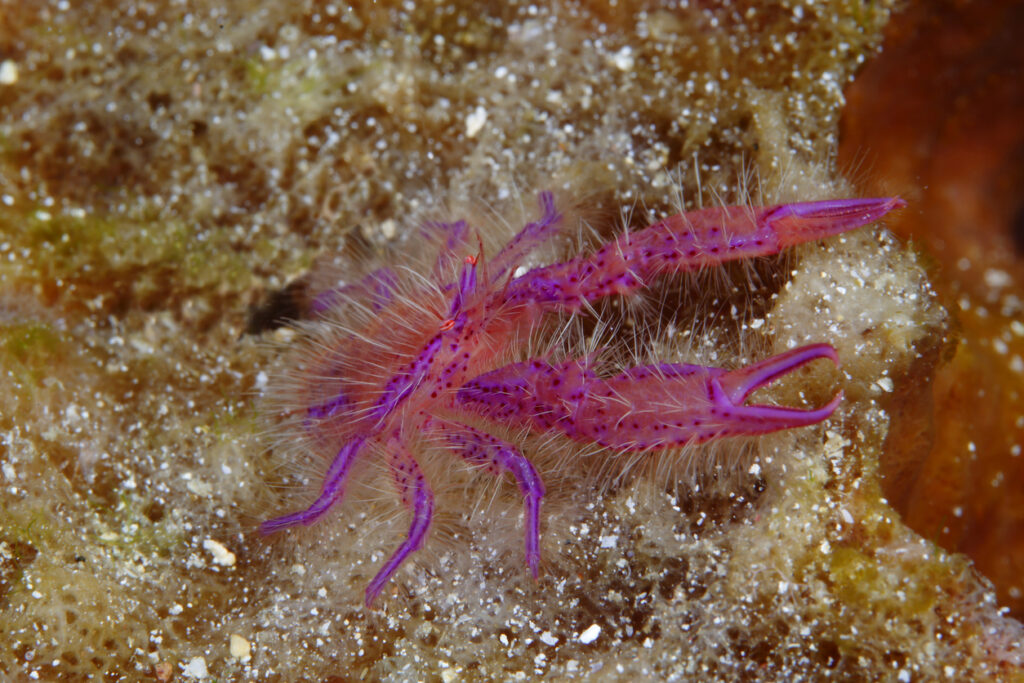
The hairy squat lobster sounds like a sea monster but looks like something out of a Lisa Frank fever dream. Found clinging to the undersides of barrel sponges and coral in the Indo-Pacific, especially around Japan and Indonesia, this tiny crustacean is only about half an inch long. Its body is covered in fine, hot pink hair-like bristles, with electric purple legs and white spots that make it look more like an underwater confetti puff than a lobster. Despite the name, it’s not an actual lobster; it belongs to the anomuran family, a group that also includes hermit crabs and yeti crabs. The hairs aren’t just for show. They trap plankton and tiny particles from the water, helping the lobster both feed and remain camouflaged in its spongey hideout.
Because of its size and tendency to stay hidden in deep crevices, the hairy squat lobster was relatively unknown until underwater macro photography became more accessible in the 1990s and 2000s. Divers now seek them out as a photographic trophy, but spotting one requires patience and perfect lighting. Like many coral reef species, they are highly dependent on their environment and vulnerable to reef degradation, especially ocean warming and bleaching events. Their coloring, while striking, is actually a form of camouflage against the pink and red sponges they inhabit. They rarely leave their perch, crawling slowly like a shaggy sea spider through their technicolor neighborhood. If you ever needed proof that the ocean has its own sense of style, this lobster brings runway-ready flair to the deep.
9. Nudibranchs
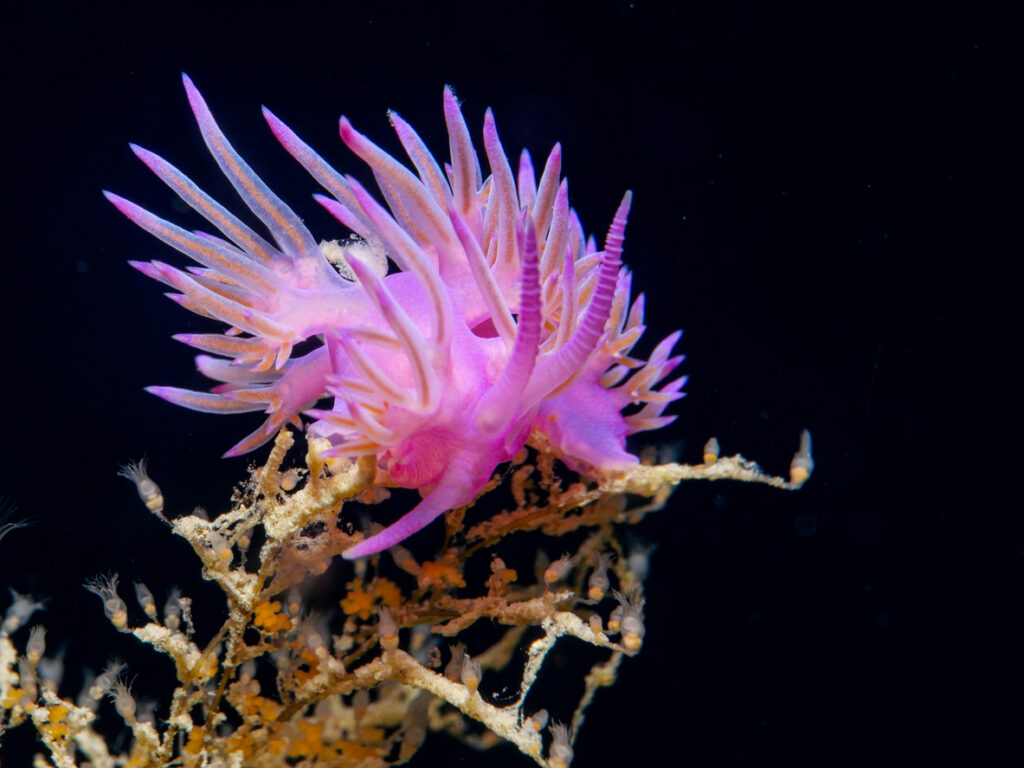
Nudibranchs are sea slugs, but don’t let the word “slug” fool you. These creatures are basically living neon signs crawling across the ocean floor. Found in oceans worldwide, from tropical reefs to icy polar waters, nudibranchs come in over 3,000 known species, many of which flaunt vibrant shades of pink. Some species, like Flabellina affinis or Hypselodoris bullocki, sport hot pink, magenta, or even bubblegum tones that make them look more like candy than anything poisonous. And that’s the point. Their bold coloring serves as a warning to predators that they’re toxic or distasteful, a defense mechanism known as aposematism. They don’t produce these toxins themselves but absorb them from their prey, often sponges, anemones, or other venomous invertebrates, and repurpose them for their own use.
What makes nudibranchs truly fascinating is their combination of alien beauty and ruthless efficiency. They’ve evolved to forgo shells, relying on chemical warfare and camouflage instead. Some species even incorporate stinging cells from jellyfish into their own bodies, becoming mobile traps wrapped in color. Despite their fragile looks, nudibranchs are predators, using specialized appendages to sniff out and consume prey in slow-motion ambushes. Most grow to only a few inches long, though their flamboyant presence makes them favorite subjects for underwater photographers and marine biologists alike. Their short lifespans, often less than a year, mean they burn bright and fast. If marine life were hosting a rave, nudibranchs would be the glittering headliners: loud, lethal, and impossible to ignore.
10. Pink Corn Snake (Albino Morph)
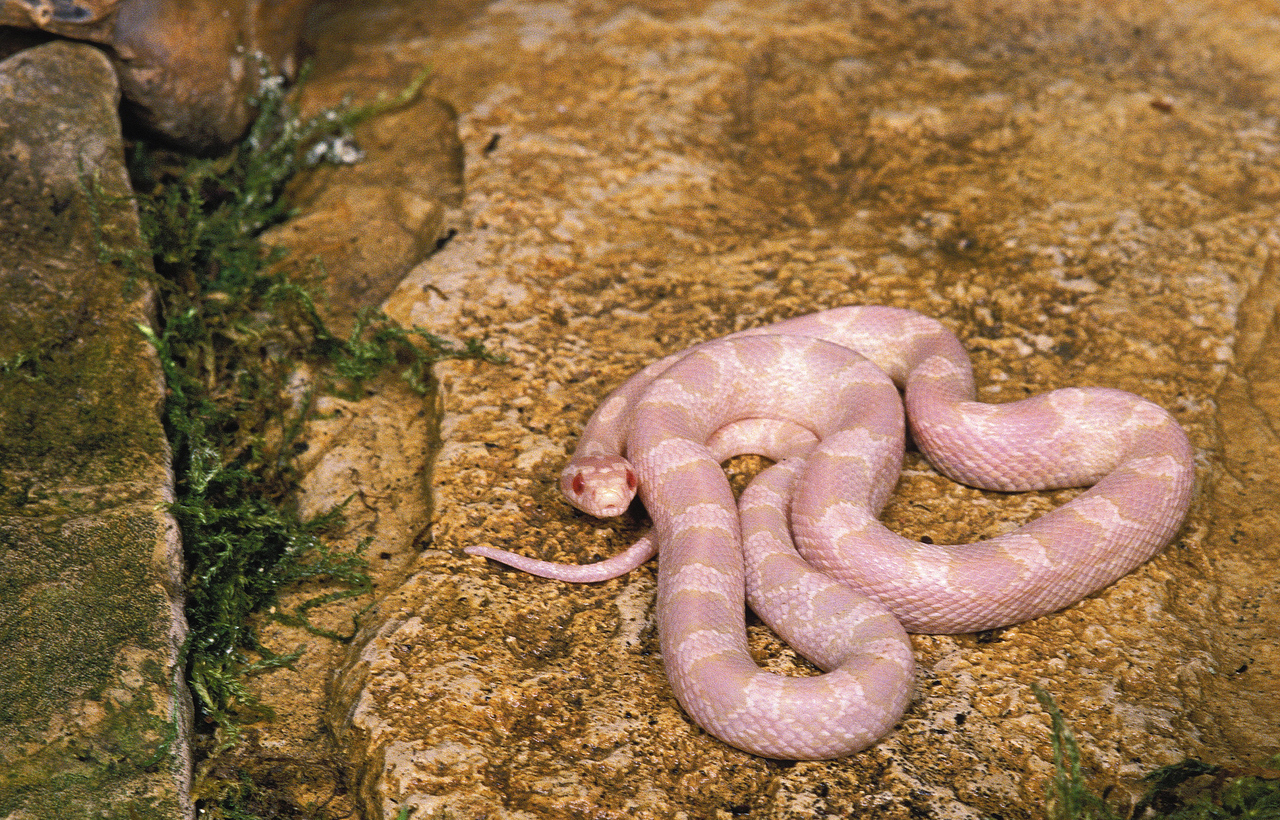
The pink corn snake isn’t found slithering through candy aisles, but it could pass for something out of a bubblegum vending machine. This soft-hued reptile is a selectively bred morph of the North American corn snake, Pantherophis guttatus, a species native to the southeastern United States. Albino or “amelanistic” corn snakes lack black pigment, resulting in pastel palettes that range from soft pink and peach to creamy white and tangerine. Breeders have taken it further by creating designer morphs, like the “snow” or “lavender” variants, that enhance the pink tones even more. Though their color screams “adorable,” they’re still effective constrictors, using coils to immobilize prey like mice and small birds.
Popular in the pet trade for their manageable size, docile nature, and striking appearance, pink corn snakes are the reptile equivalent of starter pets. They rarely grow beyond four to five feet and live for 15 to 20 years in captivity. Unlike wild corn snakes, which have dark saddles and earthy tones to blend into fields and barns, these morphs wouldn’t last long outdoors. Their light coloring makes them highly visible to predators and unsuitable for camouflage. Still, their lineage comes from hardy stock; wild corn snakes are excellent climbers, strong swimmers, and skilled escape artists. In captivity, pink morphs retain all the same survival traits, just with a little more flair. They’re the snakes that prove even the slinkiest creatures can wear pink with pride.
11. Pink Worm Snake
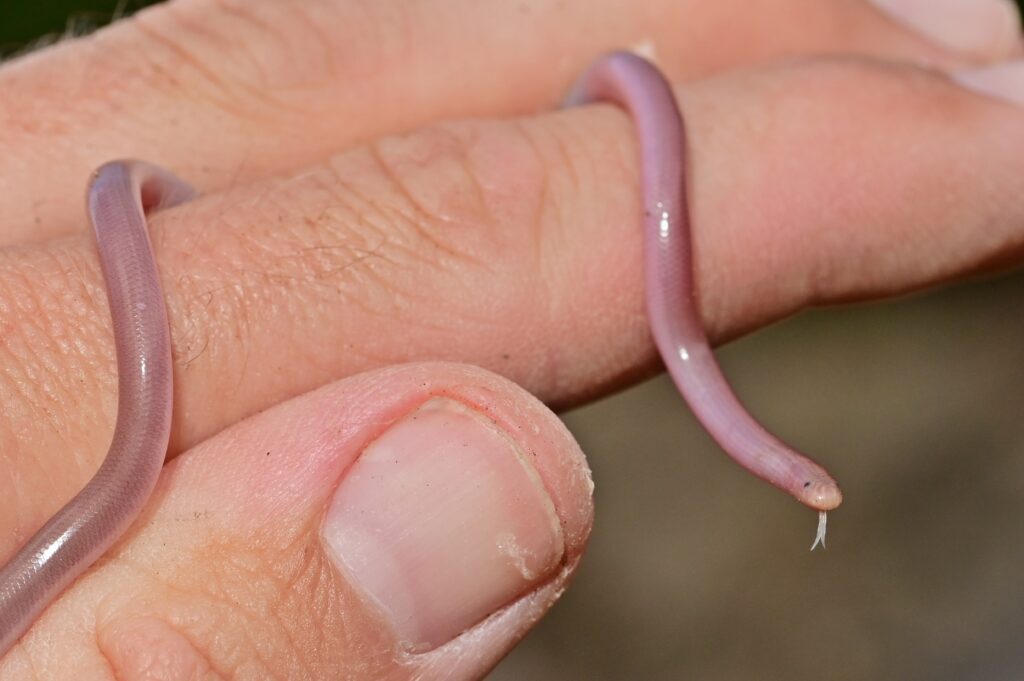
At first glance, the pink worm snake looks like exactly what its name suggests, a wriggling strand of bubblegum with a face. Found mainly in the southeastern United States, particularly in moist woodlands and under logs or leaf litter, this tiny reptile rarely grows longer than 12 inches. It’s technically a snake, not a worm, and belongs to the family Leptotyphlopidae or Typhlopidae, depending on the species. Many varieties are completely blind or have only vestigial eyes, relying on touch and chemical cues to navigate underground. Their pink coloration comes from their translucent, scale-covered skin, which allows the underlying blood vessels and muscle to show through, giving them a fleshy, almost rubbery appearance.
These snakes spend nearly their entire lives underground, surfacing only after heavy rains or when disturbed. They feed on ant and termite larvae, using a specially adapted jaw to slip into tiny crevices without resistance. Despite their harmless nature, their unusual appearance often sparks confusion or fear among people who encounter them. They’re completely non-venomous and pose no threat to humans, though their subterranean lifestyle makes them difficult to study in the wild. Some species have been mistaken for baby snakes of other kinds or even for oversized earthworms. But in truth, they’re a world apart, a strange evolutionary side note that thrives out of sight. Think of them as the secret agents of the snake world: small, stealthy, and operating beneath the surface, literally.
12. Pink Sea Star

If Patrick Star from SpongeBob had a real-world cousin, it would be the pink sea star, scientifically known as Pisaster brevispinus. This soft-toned but spiny creature lives along the Pacific coastline of North America, from Alaska down to California, lounging in tide pools and sandy seabeds like a five-armed piece of candy. Its natural color ranges from pale bubblegum to deep coral pink, making it one of the more striking echinoderms you can spot in the wild. Reaching up to two feet across, it’s no dainty decoration. This sea star is a slow-moving predator that feeds on clams, mussels, and other shelled creatures by prying them open with suction-cup tube feet. Once it cracks them even slightly, it does something truly bizarre, it everts its stomach through its mouth and digests the prey externally.
Despite its delicate appearance, the pink sea star is a key player in coastal ecosystems. Its feeding habits keep populations of bivalves in check, which in turn shapes the health of the surrounding habitat. Like many sea stars, it’s incredibly resilient, capable of regenerating lost limbs and surviving in harsh intertidal zones. However, it’s not invincible. The species has suffered in recent years from Sea Star Wasting Syndrome, a mysterious disease that causes disintegration of tissues and mass die-offs. Researchers are still investigating links to warming oceans and environmental stressors. Still, spotting a healthy pink sea star clinging to a rock is like stumbling upon a slow-motion miracle in soft pastels. It’s tough, weird, and unexpectedly gorgeous, proof that even nature’s slowest predators know how to make an entrance.
13. Baby Animals (Including Humans)

You don’t have to be rare or exotic to come into the world blushing pink; most mammals, birds, and even reptiles start life looking like tiny raw dumplings. Newborn mice, pigs, puppies, and even marsupials like kangaroos emerge nearly hairless, with translucent skin and glowing pink tones that highlight their developing blood vessels. For many species, pinkness at birth signals a lack of melanin or full fur development. It’s not a permanent color, just a stop on the way to something more camouflaged or functional. The same is true for human babies. Most are born somewhere between flushed red and pale pink, regardless of future skin tone, due to thin skin and increased blood flow in the first few hours of life.
This pink phase is biology’s equivalent of “still loading.” The circulatory system is adjusting to breathing air instead of receiving oxygen through the placenta, and the body’s melanin hasn’t kicked in yet. Premature infants often appear even pinker, and some bird hatchlings are practically glowing under the right light. While adult humans come in every shade imaginable, we all start with that universal baby-pink hue—a rare moment of biological unity across species. And unlike other animals, human parents often find this pinkness irresistibly cute, which some evolutionary psychologists believe plays a role in bonding and protection. Its vulnerability is on full display. Pink may fade, but those early days are a reminder that even the fiercest animals start out looking like marshmallows.
Pink Isn’t Just a Color—It’s a Survival Strategy
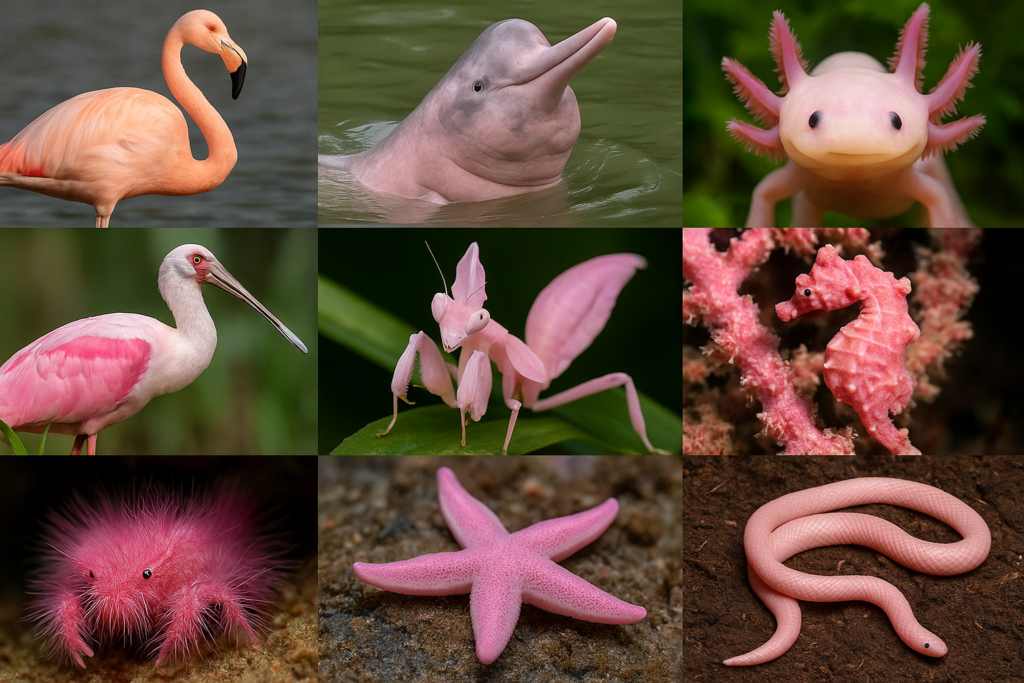
Pink isn’t just for flamingos, and it definitely isn’t just for Valentine’s Day. From jungle rivers to coral reefs, muddy woodlands to maternity wards, pink shows up in some of the most unexpected corners of the animal kingdom. In some cases, it’s a genetic mutation. In others, it’s camouflage, poison warning, or even a blush of youth. These 13 animals, including a dolphin that gets pinker with age, a snake that looks like candy, and a lobster that could pass for a drag queen, prove that evolution has a flair for drama. Whether they’re flaunting their color to attract mates, fend off predators, or simply because that’s how their genes rolled the dice, these pink creatures challenge every boring stereotype about nature being “earth-toned.”
It turns out that pink isn’t rare; it’s just hiding in plain sight. Under rocks, inside flowers, deep underwater, or wrapped in a swaddle, it’s there if you know where to look. Some species glow pink from within. Others wear it like armor. A few use it as bait. And one or two are just going through a phase. But every animal on this list reminds us that color in the wild isn’t just pretty. It’s powerful, strategic, and sometimes a complete accident. One thing’s for sure: after reading this list, you’ll never see pink the same way again.
This article, 13 Real Animals That Are Naturally Pink – And Not Just Flamingos was first published on Dailyfetch.net


